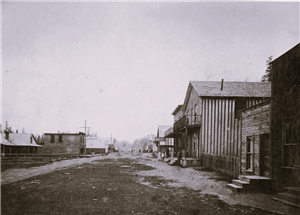On May 8, 1909, the Town of Concrete in northern Skagit County is officially incorporated as a town of the fourth class when a certified copy of the county commissioners' order incorporating the town is filed with the Washington Secretary of State's office. The new town, located on the Skagit River at the mouth of the Baker River, combines two communities that grew up on either side of the Baker River -- "Baker" on its west bank and "Cement City" on the east. Each has recently become home to a cement plant, taking advantage of the area's large deposits of clay and limestone to manufacture cement, the major ingredient in concrete. Residents and company officials decide to merge the two communities into one incorporated town, named Concrete. Voters approve incorporation by a large majority, 149 to 2, in an election held on April 27. On May 5, county commissioners approve an order certifying the election results and ordering the incorporation, which is filed with the Secretary of State three days later.
Baker and Cement City
The first homesteaders began settling in the area that would become Concrete in the 1870s and 1880s, with more arriving in the 1890s. In 1891, Magnus Frederick Miller Sr. (1848-1932) bought property on the west side of the Baker River where it empties into the Skagit from Richard Challenger, who had settled there a few years earlier. Miller named the property "Baker," opening the Baker Post Office in his home on June 30, 1892.
The neighboring community of "Cement City" grew up a little later on the east bank of the Baker River, where Amasa Everett (1849-1938) had made a homestead claim in the 1870s. Cement City owed its existence and name to Everett's discovery on his homestead of substantial clay and limestone deposits, the raw materials used in manufacturing cement. The Washington Portland Cement Company (WPCC) was founded in 1905 to utilize those deposits and Everett platted Cement City, which was built around the new cement plant.
A second cement plant was established in 1908 in Baker on the west bank of the river by the Superior Portland Cement Company (SPCC). The two cement plants quickly became the community's largest employers as cement manufacturing supplanted logging as the primary industry. Other businesses included two hotels, three general stores, three saloons, two restaurants, two pool halls, a shoe shop, meat market, bakery, confectionary, drug store, blacksmith shop, and tailor shop.
Becoming Concrete
By early 1909, residents decided they wanted to organize a municipal government and incorporate their community. After much discussion between officials of WPCC and SPCC and among residents, it was decided to merge the communities of Baker and Cement City and to incorporate the town under the name Concrete. At a meeting held in February to consider incorporation all those present were in favor. A rumor persisted long afterward that a barrel of whiskey had been provided by SPCC during the discussion of the name to be chosen for the incorporated town.
A petition was drawn up to be presented to the Skagit County commissioners requesting a vote on incorporation. On April 5, 1909, the petition was presented to the Board of County Commissioners. An election was held on Tuesday, April 27, 1909, to vote on incorporating Concrete. An estimated 1,200 inhabitants were within the boundaries of the proposed town.
The election results were overwhelmingly in favor of incorporation. When the votes were tallied, incorporation passed with 149 votes for and 2 against. After the county commissioners approved an order certifying the results and ordering the incorporation, on May 5 Skagit County Auditor J. M. Shields certified the transcript and order for filing with the Secretary of State's Office. Residents celebrated on May 8, 1909, as the incorporation took effect when the paperwork was filed and the Town of Concrete came into existence.
First Elected Officials
In the same election that approved the incorporation, the first elected officials were chosen. Daniel Dougal Dillard (1857-1932) was elected mayor, Rudolph Roggenstroh (1856-1922) treasurer, and Peter John Lindbeck (1856-1921) clerk. Elected to form the first town council were Walter Edward Jackson (1873-1968), A. B. Melville, E. L. Smith, E. W. Murphy, and A. S. Nichols. Other officials elected were L. E. Wolf as police judge, G. L. Leonard as town attorney, H. G. Cupples as town engineer, T. F. Cole as Marshal, and E. F. Mertz as health officer.
With the election out of the way, municipal improvements were in order. The first meeting was held in the Eagles Hall on May 10, 1909. The new town council immediately passed ordinances setting salaries for all officers, and to tax and control the sale of liquor.
Daniel Dougal Dillard, Concrete's first mayor, was born in Arkansas and fondly called Uncle Dan. In the 1880s he lived in Arizona where he met his business partner Rudolph Roggenstroh. They purchased the Baker River Lumber Company in 1902 shortly after arriving in Baker. Dillard married Henrietta C. Phillips (1883-1933) on Valentines Day, February 14, 1912. They would have 6 children. Dillard was killed in a car accident west of Concrete.
Over the years, Concrete expanded its boundaries several times, with annexations of additional area approved in 1912 and 1970.

